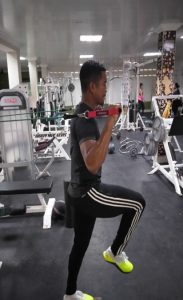With Neil Barry
“THE preservation of health is easier than the cure of disease.”- B.J. Palmer

You might have heard the phrase “prevention is better than cure”. It likely came from B. J. Palmer, an instrumental figure in developing chiropractic practice who said that “the preservation of health is easier than the cure of disease.” In sports, time lost to injury costs teams, players, and health systems significantly.
This edition of ProFormance explores reasons why prehab, targeting potential injuries and working to prevent them, is more ideal than the rehabilitation of injuries themselves.
WHAT IS PREHAB
Unfortunately in sports, injuries do occur rather often and while many of them occur as a result of accidents, there have been proven methods of prevention that help to limit the incidence of injuries.
Simple examples of injury prevention methods can be by wearing protective equipment, keeping the playing surface as free from danger as possible, and by the implementation of rules for keeping athletes safe, such as penalties for dangerous tactics.
This article is about forms of injury prevention that are more intrinsic, taking into consideration the individual athlete and how they can physically prepare their bodies for the rigours of their sport, and to minimize on the injuries they are most likely to experience.
For the purposes of this column, Prehabilitation, or prehab, describes measures taken to enhance the capacity of an athlete to meet the demands of the stresses in his/her sport.
Simply put, prehab considers the physical stresses your body is exposed to, and works to help you manage them before injuries happen.
FACTORS TO CONSIDER IN PREHAB
You might be asking how do I know what injuries to prevent if they haven’t happened yet? The key is to look closely at your sport. If you are in an individual sport, it may be a little easier to look at other athletes who do what you do, and read about the injuries they have had, or ask experienced athletes about which injuries affected them.
If you’re in a team, then the same principle can be applied to other athletes who play the same role. E.g. a goalkeeper may seldom experience the same injuries than those of a striker. So you should look into injuries experienced by other athletes who play the same role as you.
Another key aspect of prehab would be to assess yourself. Consider your own history of injuries, especially if you’ve had recurring ones. It would also be very beneficial to seek out a qualified health and fitness professional who can help assess you for physical asymmetries such as leg length discrepancies, muscle imbalances and faulty movement patterns.
Additionally, you should arm yourself with knowledge. A simple Google search may point out, for example, that if you have had an ankle sprain, you become much more likely to have another one, and there are training methods to minimize that.
TIPS ON IMPLEMENTING PREHAB
After you have been assessed or you have identified the injuries most likely to affect you, the next step may be to make time in your training to carry out exercises that strengthen the structures most likely to be affected.
The British Journal of Sports Medicine published research which showed that strength training reduced sports injuries to less than a third, and even halved the incidence of some types of injuries.
Even FIFA has developed a warm up program that includes strength exercises that has been shown to reduce football injuries, called FIFA 11+.
You should also keep in mind that it is not always strength training that go into prehab, as in the case of preventing ankle injuries, exercises that improve your balance and coordination are also helpful.
With regards to implementing prehab, be sure to consult with a health and fitness professional to ensure you choose the right exercises suited to you and your sport, and ask about the correct ways to implement them for your safety.
Finally, do not be afraid to take some time during a long competitive season to work on the nagging pain you might have that may be worsening the more you compete.
Additional information on the injuries that are common in specific sports and the proven training methods to minimize them may be found on the upcoming ProFormance Facebook page. Top teams and athletes around the world are investing more heavily in prehab, do not be left behind. Better to spend your time in the gym now than your money on a table later.
If there are specific topics you would like to see discussed here, or you have questions, you can email proformance592@gmail.com or leave a message on the Facebook page.



.jpg)








